
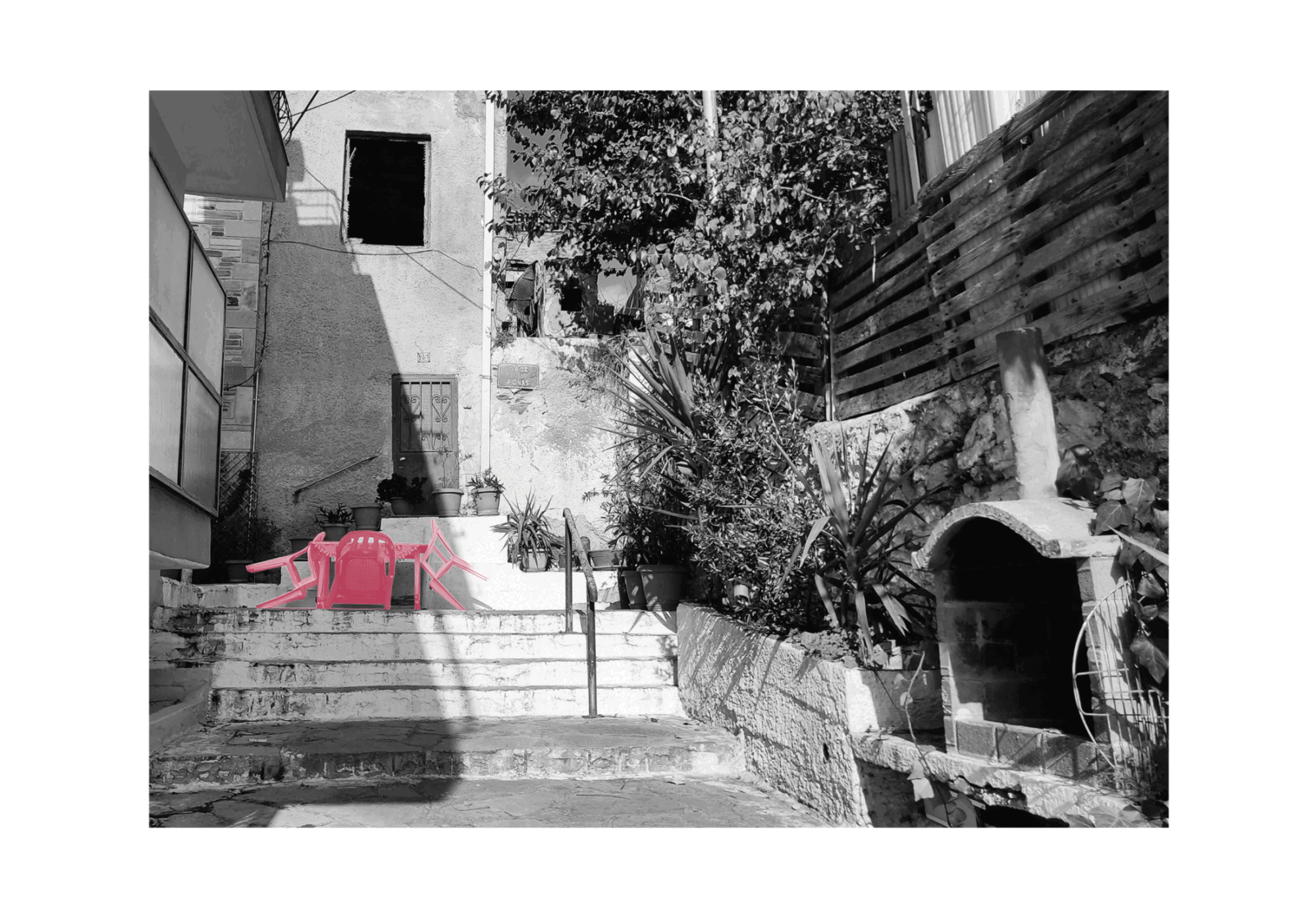

Όπως είναι γνωστό από διάφορες κοινωνικοχωρικές μελέτες, ο καλύτερος χώρος ανάπτυξης κοινωνικών σχέσεων, αλλά και της γειτονικότητας σε μια περιοχή, είναι ο δημόσιος χώρος. Ο δημόσιος χώρος στην περιοχή της Άνω Πόλης, αποτελεί σίγουρα μια πολύ ιδιαίτερη πτυχή του ζητήματος, με το χαρακτηριστικότερο στοιχείο να είναι ο δρόμος και η σχέση του με τις αυλές των μικρών κατοικιών. Το ελάχιστο μέγεθος των σπιτιών [30 τ.μ. περίπου] αλλά και οι στενοί κοινωνικοί δεσμοί ωθούν τους κατοίκους να διαχυθούν προς τον εξωτερικό χώρο, ζώντας παράλληλα και μέσα στο σπίτι, αλλά και έξω, στην αυλή και στον δρόμο της γειτονιάς τους.
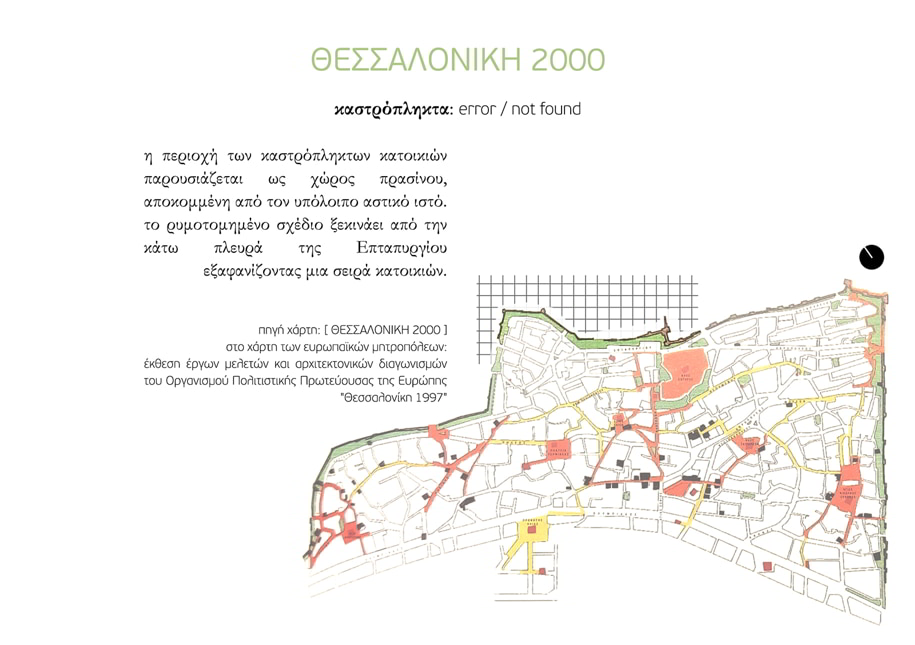
Η γειτονιά των καστρόπληκτων αποτελεί μια ιδιαίτερη περιοχή, για την οποία έχουν γίνει πολλές συζητήσεις γύρω από την σχέση της με το τείχος, αλλά ακόμη και για την ίδια την σημαντικότητά της. Δεν είναι λίγες οι φορές, όπου έχει γίνει προσπάθεια για την υποτίμηση ή ακόμα και την διαγραφή της συμβολής στην ιστορία της πόλης, παρά το γεγονός, ότι αποτελεί ένα αναπόσπαστο κομμάτι της. Τα κτίσματα των καστρόπληκτων λείπουν από τις επίσημες ρυμοτομικές μελέτες, καθώς η περιοχή χαρακτηρίζεται ως “ζώνη πρασίνου” παρότι ακόμα και σήμερα άνθρωποι ζούνε κανονικά μέσα σε αυτά, ενώ πολλά έχουν κατεδαφιστεί με στόχο την «ανάδειξη του τείχους» και την μετατροπή της περιοχής σε μια «καθαρή» ελκυστική ατραξιόν.
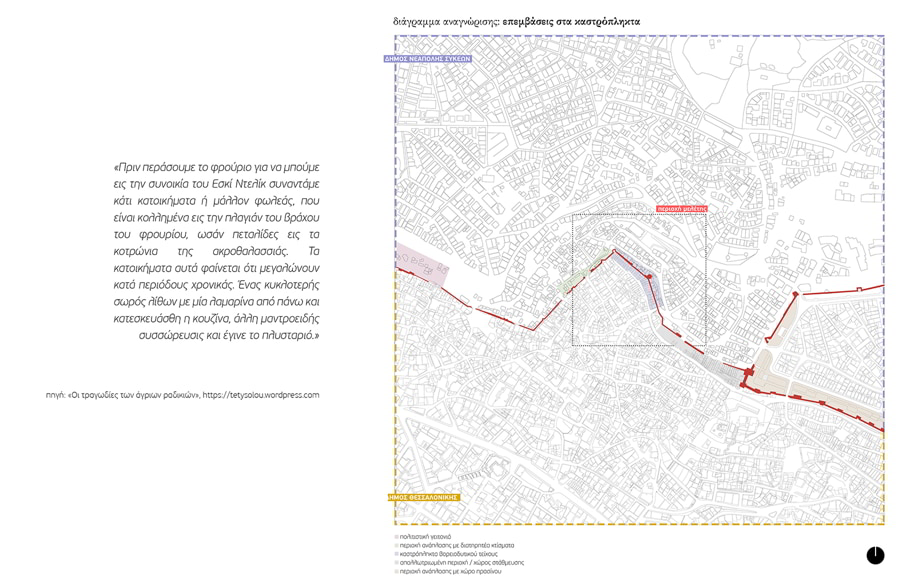
Στην συγκεκριμένη διπλωματική εργασία, επιλέγουμε να μελετήσουμε την γειτονιά στο βορειοδυτικό τείχος, και συγκεκριμένα στην αρχή της οδού Επταπυργίου. Η συμβιωτική σχέση των προσφυγικών κατοικιών με το τείχος αποτελεί το εντονότερο στοιχείο που χαρακτηρίζει την περιοχή επέμβασης. Μέσα από την πρότασή μας προσπαθούμε να αναστρέψουμε την προσπάθεια επιλεκτικού σβησίματος της μνήμης αναδεικνύοντας όλες τις πλευρές της ιστορίας της περιοχής.
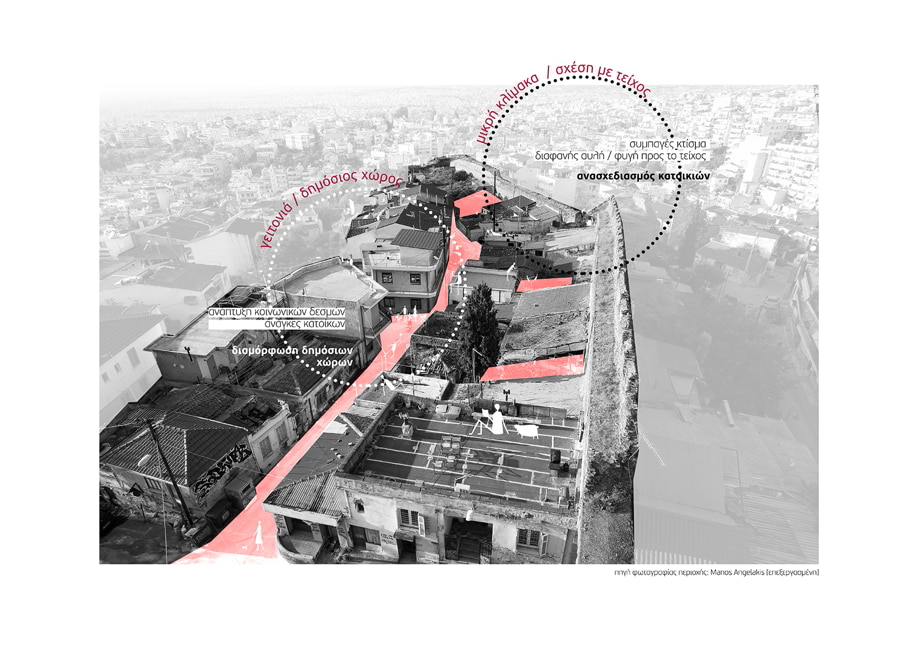
Προτείνουμε αυτό να γίνει από την μία, μέσα από τον ανασχεδιασμό ορισμένων κατοικιών ώστε να βελτιωθούν οι συνθήκες κατοίκησης και από την άλλη μέσα από την δημιουργία δημόσιων χώρων που θα φιλοξενούν χρήσεις με σκοπό την ενίσχυσης της έννοιας της γειτονιάς, σχεδιάζοντας με βάση τις ανάγκες των κατοίκων.
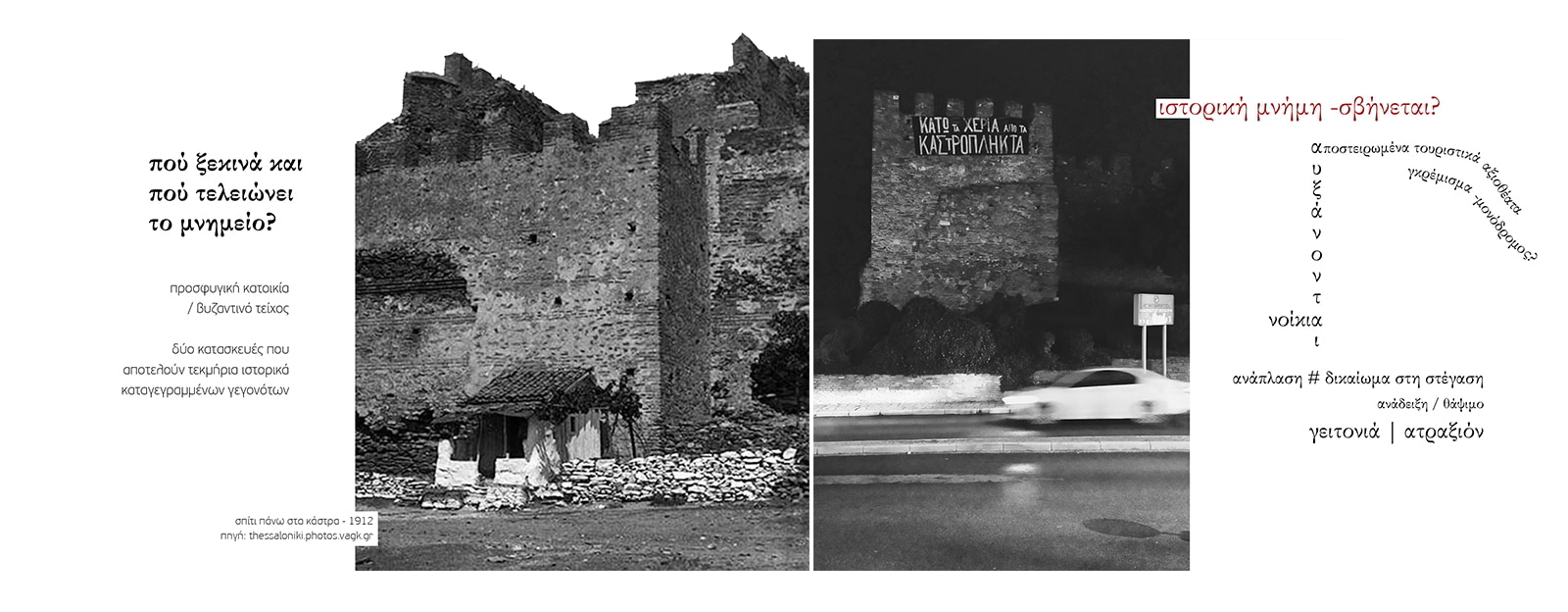
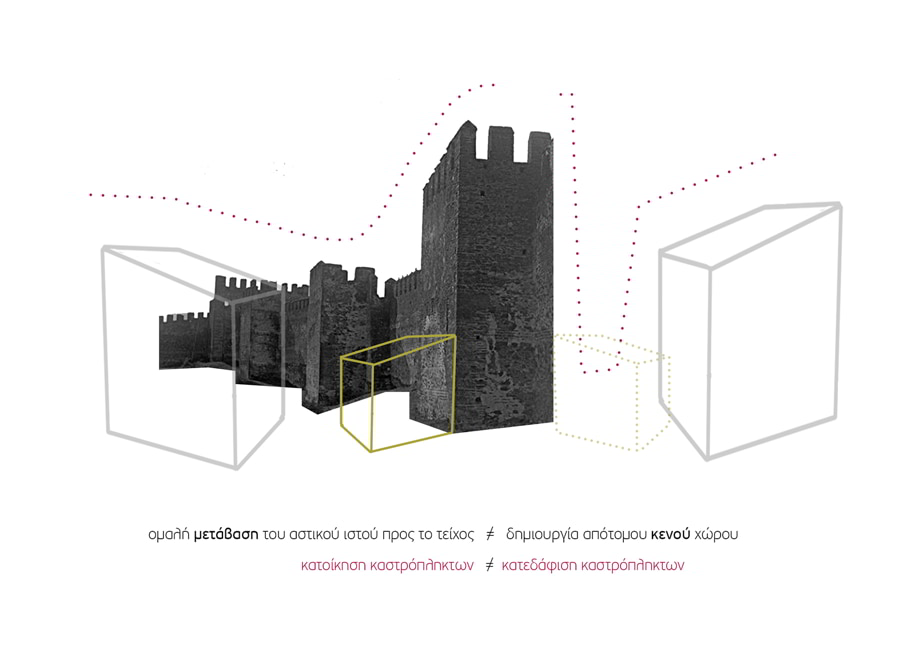
Στοιχεία έργου
Symbiosis with the wall: Interventions in a neighborhood of ‘Kastroplikta’, diploma thesis project by Theodoridi Elina and Georga Eirini. The city of Thessaloniki has always been one of the most characteristic cities of multiculturalism. One of the most important milestones in its history is the arrival of refugees due to the Asia Minor disaster and the exchange of populations.
-text by the authors
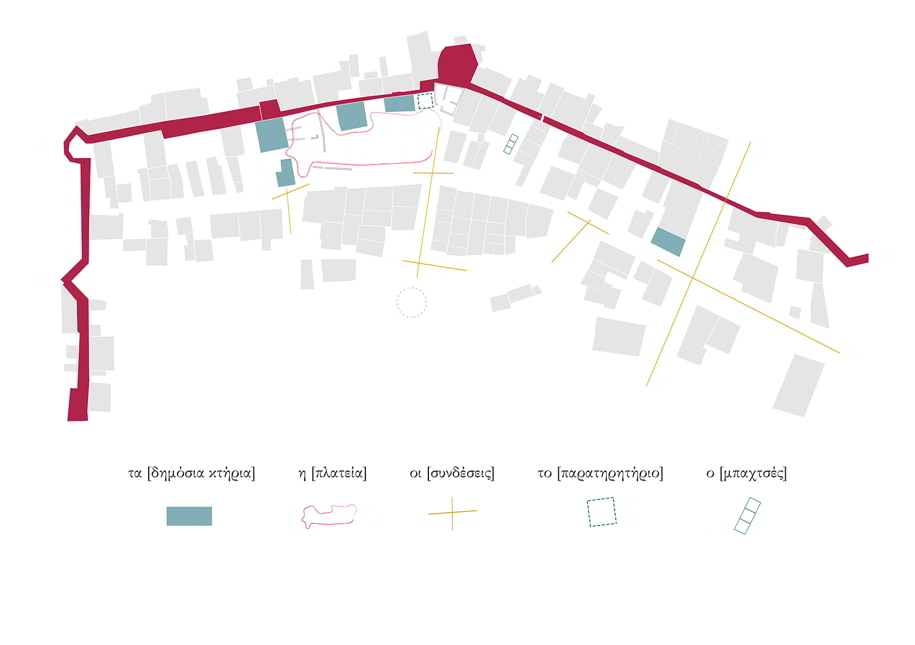 From 1922 onwards, a large number of refugees gradually arrived in the city, trying to create their lives from scratch. The need for immediate housing led either to the settlement of refugees in empty Turkish houses or to the rapid construction of simple houses in various parts of the city. One of the neighbourhoods that were created was the one in the Upper City (Ano Poli). Refugees trying to build a new house at the lowest possible cost – as their financial situation was bad – ‘exploited’ the Byzantine wall and built on top of and in direct contact with it, in order to avoid the expense of one wall of the house.
From 1922 onwards, a large number of refugees gradually arrived in the city, trying to create their lives from scratch. The need for immediate housing led either to the settlement of refugees in empty Turkish houses or to the rapid construction of simple houses in various parts of the city. One of the neighbourhoods that were created was the one in the Upper City (Ano Poli). Refugees trying to build a new house at the lowest possible cost – as their financial situation was bad – ‘exploited’ the Byzantine wall and built on top of and in direct contact with it, in order to avoid the expense of one wall of the house.
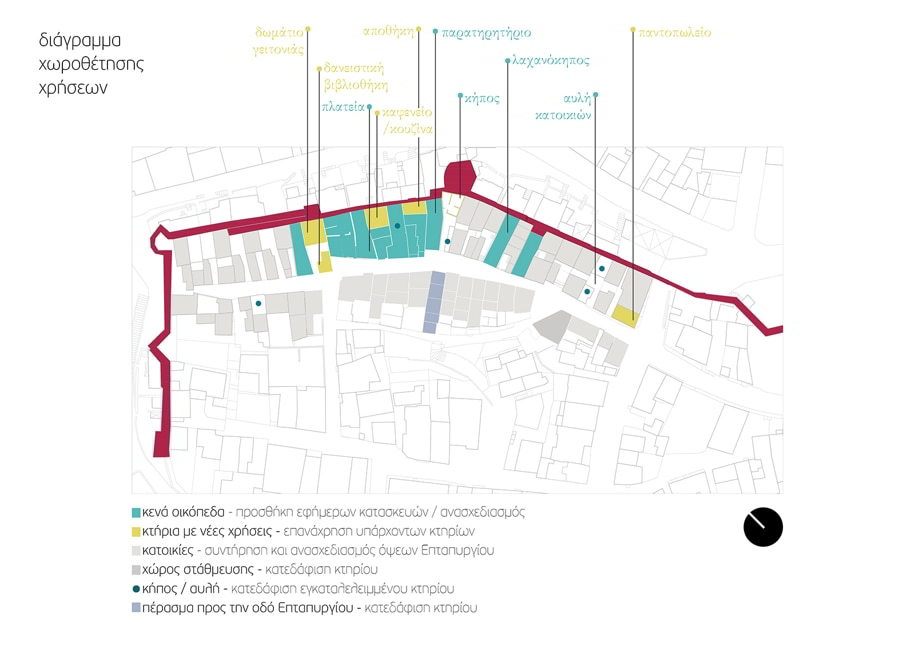
This fourth wall of the house temporarily borrows part of the ancient wall and therefore takes on the everyday uses of a house. It becomes storage space, the back of a bed or a kitchen. Like any social group, which is “threatened” within society, the refugees of the time clustered together in neighbourhoods, with the sole aim of existing within the city. Thus, the neighborhood of “Kastroplikta” is created, in which social ties play the strongest role in the continuation of their existence.

As it is known from various socio-spatial studies, the best place for the development of social relations, and also neighbourhood in an area, is the public space. Public space in the Upper Town area is certainly a very particular aspect of the issue, with the most distinctive element being the street and its relationship with the yards of small houses. The minimum size of the houses [about 30 square meters] and the close social ties push the residents to diffuse towards the outdoor space, while living both inside the house and outside, in the yard and on the street of their neighborhood.
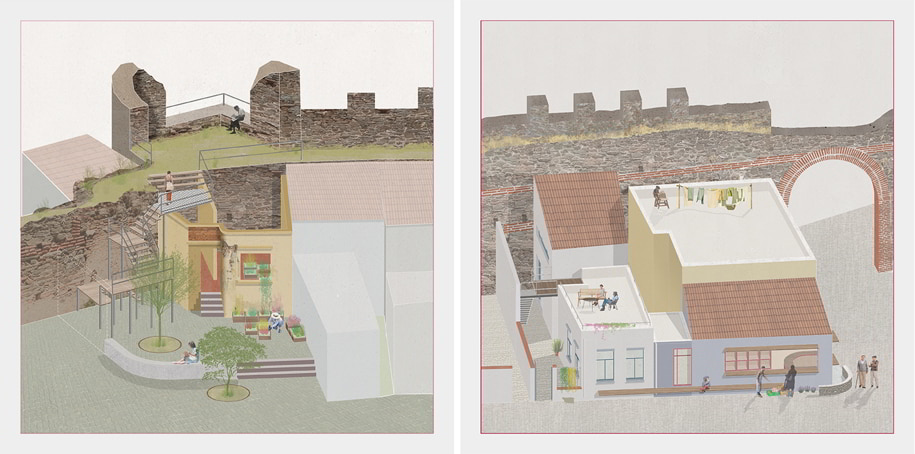
The neighbourhood of “Kastroplikta” is a special area, for which there has been much debate about its relationship with the wall, but also about its importance. There have been many times when attempts have been made to devalue or even erase its contribution to the history of the city, despite the fact that it is an integral part of it. The buildings of the castaways are missing from the official town planning studies, as the area is classified as a “green zone” even though people still live in them normally today, and many have been demolished in order to “highlight the wall” and turn the area into a “clean” touristic attraction.
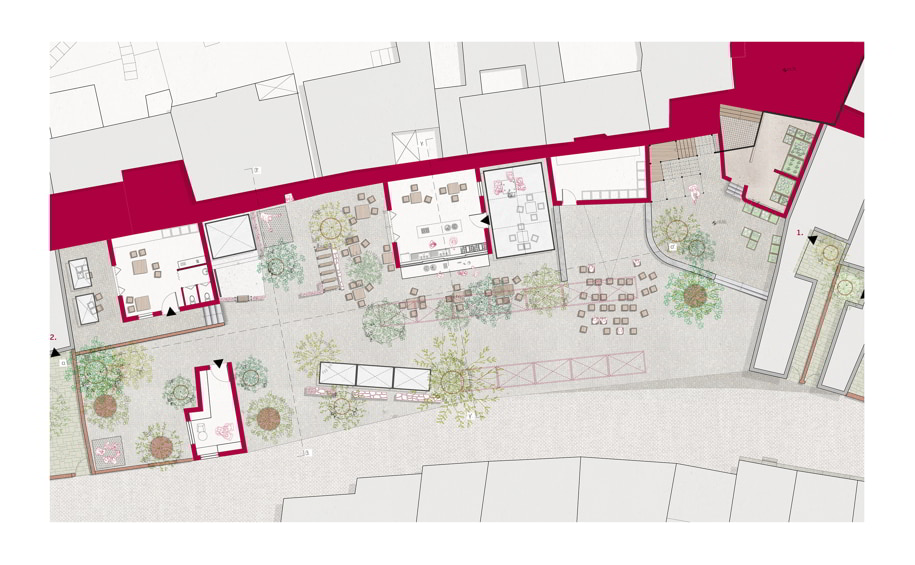
In this thesis, we choose to study the neighborhood at the northwestern wall, specifically at the beginning of Eptapyrgiou Street. The symbiotic relationship between the refugee housing and the wall is the most pronounced element that characterizes the intervention area. Through our proposal we are trying to reverse the attempt to selectively erase memory by highlighting all aspects of the history of the area. We propose to do this on the one hand, through the redesign of some houses to improve living conditions and on the other hand, through the creation of public spaces that will host uses aimed at strengthening the concept of neighbourhood, designing according to the needs of the inhabitants.
Facts & Credits
READ ALSO: Έπαινος συμμετοχής στο Φοιτητικό Αρχιτεκτονικό Διαγωνισμό Ιδεών «ΦΑΡΜΑΚΕΙΟ 2030», για την πρόταση των Aμπαδιωτάκης Πέτρος και Γιαννακοπούλου Νικολέτα